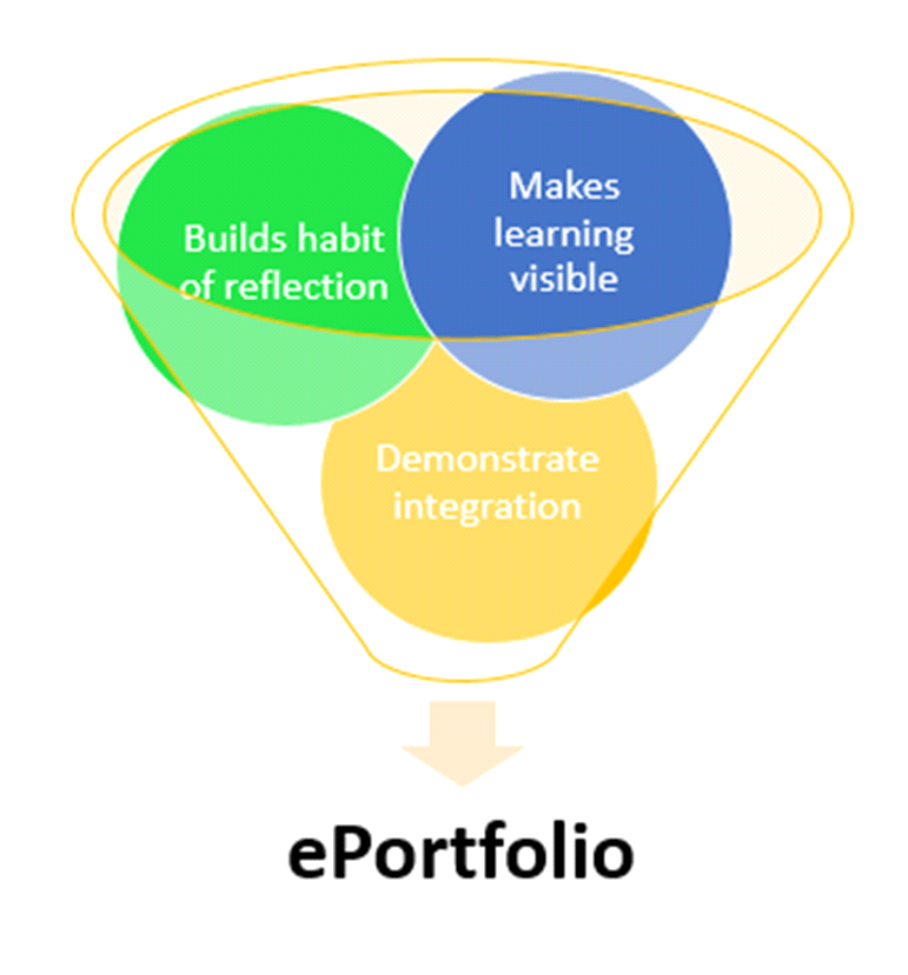What is an ePortfolio?
An ePortfolio is a valuable tool in the development of a learner. It is more than an electronic record keeping system; it is intentional designed instructional approach that encourages periodic reflection on and deepen of learning by connecting and making sense of experiences inside and outside of classroom.
An ePortfolio allows the student to demonstrate learning beyond what is on an official transcript by showcasing best work, co-curricular experiences, and the student’s own interpretation of how these all combine to be larger than the sum of their parts in the student’s development.

What students learn while at UConn is more than just the classes they take. It is a combination of knowledge from classes, co-curricular activities, and current and previous experiences. Through the integration of this knowledge and experience from all aspects of life, the ePortfolio can create a complete picture of abilities including knowledge, skills, and attitudes.

(Adapted from Tosh, Werdmuller, Chen, Penny Light, and Haywood, 2006, 27)
An ePortfolio consists of artifacts or evidence and reflections that demonstrate integration of knowledge, skills, attitudes, and experiences. While it is possible to just post artifacts of learning, it is the reflection on how this learning integrates with experiences outside the classroom or in other classes that demonstrates the strength of that learning. The artifacts and evidence in an ePortfolio demonstrates learning and growth. These may be artifacts from varying stages of development or it may be a finished project. While the artifact itself provides evidences of what was done, it requires framing to show the deeper learning. This framing is provided by reflection statements. Reflection builds in meaningful connection to learning. According to John Dewey’s Democracy and Education: an Introduction to the Philosophy of Education in 1916, education is a “reconstruction or reorganization of experience, which adds to the meaning of experience.” Not only does reflection make learning visible to the learner and others, reflection allows student to make sense of new experiences in relation to themselves, their environment, and previous experiences. Through this linking, reflection creates connections and deepens learning. An ePortfolio can be used for multiple purposes. The primary uses are to demonstrate learning or as a showcase/professional ePortfolio.
A learning ePortfolio is typically created as part of a course or program of study as a means to achievement of learning objectives or demonstration of achievement. A showcase or professional ePortfolio is intended to demonstrate the highlights of the student’s academic or professional experience, often for employment purposes. These types of ePortfolios are not exclusive of each other. A well-developed ePortfolio can be utilized in multiple courses, throughout general education, or as part of an academic program to demonstrate learning. Because it demonstrates the student’s abilities, it can then be utilized during their search for a career or graduate school. Faculty can assist students in creating an ePortfolio that goes beyond demonstrating knowledge, skills, and attitudes developed in their course(s).
Through course activities, faculty can help students to demonstrate integrative learning. Levels of ePortfolio development:
| Content focused | Content & Process of Learning focused | Content, Process, and Connections in Learning focused | Integrative Learning | |
|---|---|---|---|---|
| Artifacts/demonstrations of learning | Artifacts/demonstrations of learning | Artifacts/demonstrations of learning | Artifacts/demonstrations of learning | |
| Reflections on the artifacts | Reflections on the artifacts | Reflections on the artifacts | ||
| Connections made between content in the eportfolio | Connections made between content in the eportfolio | |||
| Use of the eportfolio for identity development; connection between self and content of the eportfolio |
Source: Leveraging the eportfolio for integrative learning: a faculty guide to classroom practices for transforming student learning, by C. Reynolds and J. Patton, 2014, Stylus. In 2003 Dee Fink developed a taxonomy for significant learning. His taxonomy shows us that learning involves more than foundational knowledge and the application of that knowledge. For significant learning, integration across knowledge, skills, and experience must occur with steps towards learning how to learn and inclusion of the human dimension. An ePortfolio is a collection of work that showcases learning, achievements, growth, and experience over time.
An ePortfolio can contain a variety of types of evidence of learning. It may contain all or some of the following:
- Evidence related to courses or major
- Writing samples
- Projects prepared for class
- Evidence of creativity and performance
- Evidence of extracurricular or co-curricular activities
Although students and faculty may have other ideas, here are ideas of artifacts: By expanding beyond just sharing artifacts, the student can work towards a Comprehensive Learner Record. The use of Portfolium allows students to demonstrate all the aspects of the Comprehensive Learner Record if utilized to its full potential.